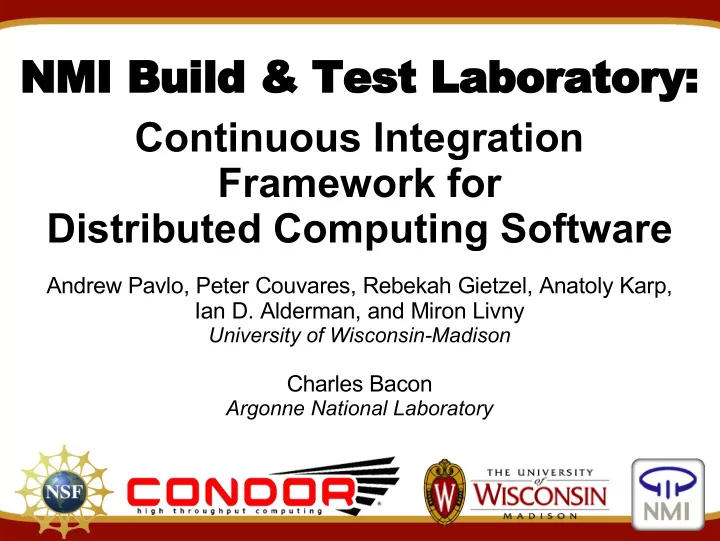

NMI Build & Test Laboratory: Continuous Integration Framework for Distributed Computing Software Andrew Pavlo, Peter Couvares, Rebekah Gietzel, Anatoly Karp, Ian D. Alderman, and Miron Livny University of Wisconsin-Madison Charles Bacon Argonne National Laboratory 1
Motivation Motivation ● Difficult to reliably build and test software. ● Build and test system that allows for: – Dependability – Traceability – Manageability – Portability – Extensibility 2 LISA 2006 – Washington, DC
Brief History Brief History ● Condor is a distributed batch system developed at the University of Wisconsin-Madison. ● The Condor team was building and testing software by hand: – Every release took weeks/months to complete. – Developers were assigned platforms to “shepherd”. ● Oracle shamed/inspired us 3 LISA 2006 – Washington, DC
Oracle's Build & Test System Oracle's Build & Test System ● Oracle used distributed computing to automate their build/test cycle, with great success. ● Oracle selected Condor as the resource manager underneath their build and test system for their flagship database server product: – Automatic nightly builds. – Extensive regression testing. ● If Oracle can do it, why can't we? 4 LISA 2006 – Washington, DC
NMI Build & Test Framework NMI Build & Test Framework ● Framework for building/testing software in a heterogeneous, multi-user, distributed computing environment. ● Abstracts the build/test procedures from the technology needed to execute on multiple resources. ● Built on top of Condor technologies. ● Part of NSF's Middleware Initiative (NMI) 5 LISA 2006 – Washington, DC
Framework Design Framework Design Principles Principles ● Tool independent ● Lightweight ● Explicit environments ● Central results repository ● Fault tolerant ● Explicit task separation 6 LISA 2006 – Washington, DC
Using the Framework Using the Framework ● Users define a set of build/test procedures, and declare software dependencies and target platforms. 7 LISA 2006 – Washington, DC
Using the Framework Using the Framework ● This information is submitted to the framework and stored in the central repository. 8 LISA 2006 – Washington, DC
Using the Framework Using the Framework ● The build/test procedures are then translated into an execution workflow. 9 LISA 2006 – Washington, DC
Using the Framework Using the Framework ● This workflow is submitted to Condor, which then submits build and test subtasks, along with special framework software, to one or more computing resources. 10 LISA 2006 – Washington, DC
Using the Framework Using the Framework ● When the build/test is complete, the results are sent back to the central repository and made available at multiple user interfaces or for future builds and tests. 11 LISA 2006 – Washington, DC
Building Software Building Software ● Automation: – Encapsulate procedures in self-contained entities. ● Resource availability: – Maintain balance between continuous integration practices and on-demand access to resources. ● Reproducible builds: – External software and tool chain provenance. ● Portable build environment: – No dependencies on “local” capabilities. 12 LISA 2006 – Washington, DC
Software Testing Software Testing Capabilities Capabilities ● Use any testing harness/suite. ● Cross-site testing: – Test services across administrative boundaries. ● Cross-platform binary compatibility testing: – Example: “Deploy Linux binaries on FreeBSD” ● Version backlog testing: – Run new tests on old binaries. 13 LISA 2006 – Washington, DC
Current & Future Research Current & Future Research ● Parallel testing: – Synchronized deployment of services on multiple machines. – Test communication compatibility (platforms/versions) ● Automatic cross-site job migration: – Jobs automatically routed to remote sites when local resources are unavailable to satisfy requirements. – Completely transparent to users. 14 LISA 2006 – Washington, DC
Current & Future Research Current & Future Research ● Virtual machine support: – Maintain cache of available OS VM images. – Inject build & test scripts inside of VM image. – Extract appropriate status, log, and job artifacts. – Automatic discovery of image configuration. ● Integration with other software quality projects: – ETICS Project at CERN – OMII-UK/Japan – Assisting Yahoo!, Hartford Financial, and others... 15 LISA 2006 – Washington, DC
Acknowledgments Acknowledgments ● Research is supported in part by NSF Grants: – No. ANI-0330634 – No. ANI-0330685 – No. ANI-0330670 16 LISA 2006 – Washington, DC
Availability Availability ● The NMI Build & Test Laboratory continuous integration framework is available for download at our website under a BSD-like license: http://nmi.cs.wisc.edu http://nmi.cs.wisc.edu 17 LISA 2006 – Washington, DC
Job Openings Job Openings ● The Condor Project is hiring! – System Administrator – Windows Systems Programmer – Unix Programmers http://www.cs.wisc.edu/condor http://www.cs.wisc.edu/condor 18 LISA 2006 – Washington, DC
19 LISA 2006 – Washington, DC
NMI Web Interface NMI Web Interface 20 LISA 2006 – Washington, DC
ETICS Client ETICS Client 21 LISA 2006 – Washington, DC
Recommend
More recommend